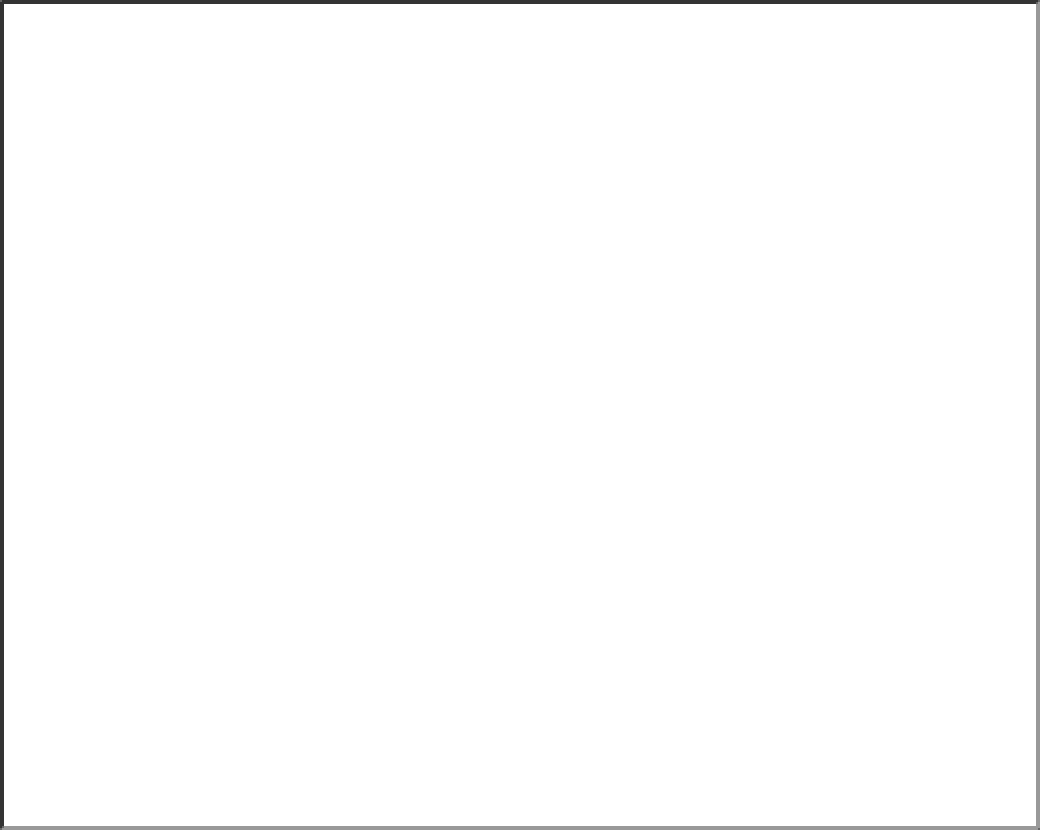03/07/2024
Read Time: 7 Minutes
Right now, I'm working on a fun project where I have a lot of creative control. It’s always a bit daunting, but I love it because it gives me a great excuse to dive into research and bring detailed design docs to meetings. I like over-researching for these things. I did it at uni, I do it in my professional life and I’ll probably do it forever. Seriously, if I could have any job it would be full-time student. I'd like to study degree after degree, back-to-back just to learn about neat things. But I digress.
What I’m getting at is that I’ve dug deep into diegetic framing developing my creative vision for one of my current projects. I’ve rejigged some of the design documentation I’ve been working on into this post as a kind of peek behind the curtain into how research informs my creative process. I’ve even included some design insights and sketches I’ve been working on! Nothing that gives away too much though, we’re keeping this low-key for now. Really, I just want an excuse to talk about diegetic design because I think it’s interesting,
We answer two questions for diegetic components in interactive digital narratives:
- Is the component in the game story? YES
- Is the component in the game space? YES
ie. if we could ask Mario, would he recognise its existence?
Mario, do you know about goombas?
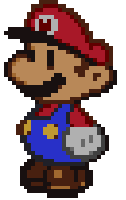
Yes! He really knows that one. He might even stomp one later on his way to save the princess. It’s diegetic!
Mario, do you know about the pause menu?
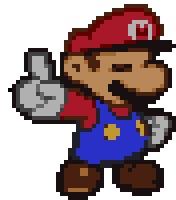
No! He is unaware that he is being marionetted by the player, who may interrupt his existence and his entire world because the microwave beeped. Mario thinks he has agency, and the world continues uninterrupted from his perspective. It exists outside of the game story and the game space. This component is not diegetic!
That’s cool and all, but you’re likely wondering why it even matters. It’s not like Mario 64 would be better designed if Mario goes “You-a paused-a mah game!” whenever you hit start. That’s because we take a lot of this for granted as players, it just is the way it is and that feels intuitive.
As designers, we must analyse these elements, it is only intuitive to players because of our hard work. Diegetic components give players cues and information framed within the game’s narrative and we must leverage this to create fun and intuitive experiences that players take for granted.
Framing gameplay elements within the game's setting can enhance narrative depth, thematic cohesion, and player immersion. Integrating these elements diegetically can allow us designers to create a distinctive and memorable game that effectively engages players.
Let’s look into a couple of my favourite examples:
Narrative Integration: Katana Zero
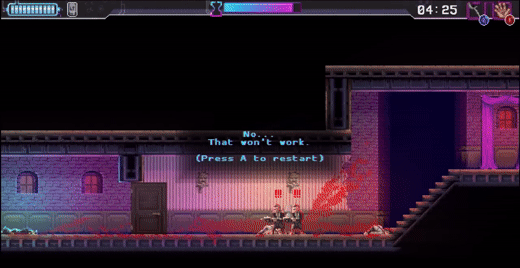
In Katana Zero, the core gameplay mechanics transcend functionality to become a narrative tool. The protagonist, Zero, utilises precognition to strategise actions by abusing a time-altering drug, intertwining the bullet-time and respawning gameplay mechanics within the fabric of the game story. Each time the player dies, Zero acknowledges that this method won't work before a new attempt. Other characters abusing this drug eventually take notice of Zero's abilities, commenting on his ability to slow down the passage of time and seemingly predict the short-term future.
The drug, a pivotal part of the game's narrative, shapes the storyline and Zero's interactions, adding depth to the gameplay experience. Integrating the drug into the gameplay mechanics ensures a cohesive and immersive experience, with every aspect of the game revolving around its pervasive influence.
Thematic Cohesion: Hades
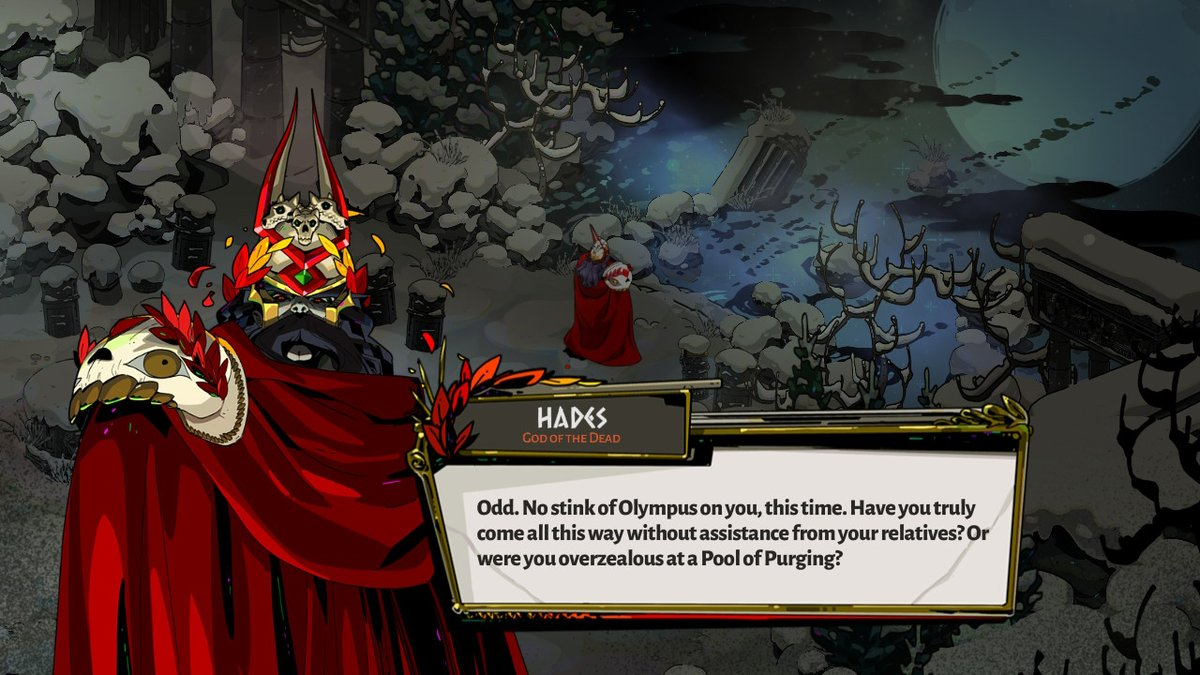
Hades leverages the Roguelike genre to explore themes of perseverance, mortality, and the cyclical nature of life and death. Each escape attempt by the protagonist, Zagreus, culminates in death until the player eventually succeeds, with each death returning Zagreus to the beginning, emphasising the life-death cycle.
This cycle is integral to the roguelike genre, emphasising each death a part of Zagreus's journey. As Zagreus progresses, he grows stronger, and this growth, along with his repeated deaths, is acknowledged in character dialogue. These repeated deaths and resurrections frame Zagreus's struggle in contrast to the eternal existence of the gods to reinforce thematic underpinnings.
Gameplay Expectations: Crazy Taxi
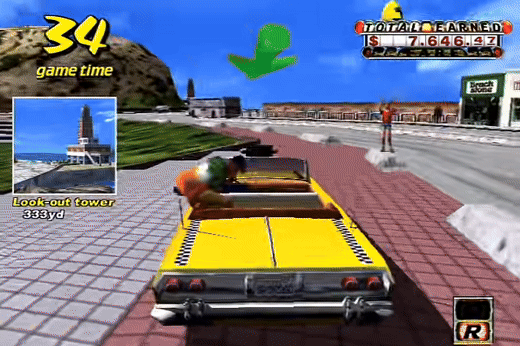
Crazy Taxi manages player expectations by framing the driving experience as a taxi job. Instead of a typical high-score mechanic, the score counter is framed as a taximeter fare to quantify the player's success, directly linking the avatar character’s earnings to the player's performance. This design choice intrinsically motivates players to drive faster, smoother, and execute riskier manoeuvres to maximise their fares and, consequently, the driver's earnings.
The fare meter, as opposed to a traditional high-score mechanic, effectively incentivises player performance by embedding a narrative connection that resonates with the player's objectives By earning cash for the player character, the game fosters a stronger connection between the player and the character, making the experience more meaningful and engaging.
Impact
Now, let’s get real academic about it all. After all, in order to apply our learnings to a new creative work, we will have to approach our findings with careful consideration to consistency and communicability.
Erica Kleinman provides a model for distinguishing and analysing diegetic elements in single-player interactive experiences. It focuses on distinguishing between diegetic and non-diegetic elements, and how these elements affect player interaction and narrative progression. The model helps identify and examine the boundaries of the story world, thus improving communication between game designers and players about what actions and elements influence the narrative and connected interactive elemnts.
The Crazy Taxi Fare Counter/High Score metre fit to Kleinman’s model:
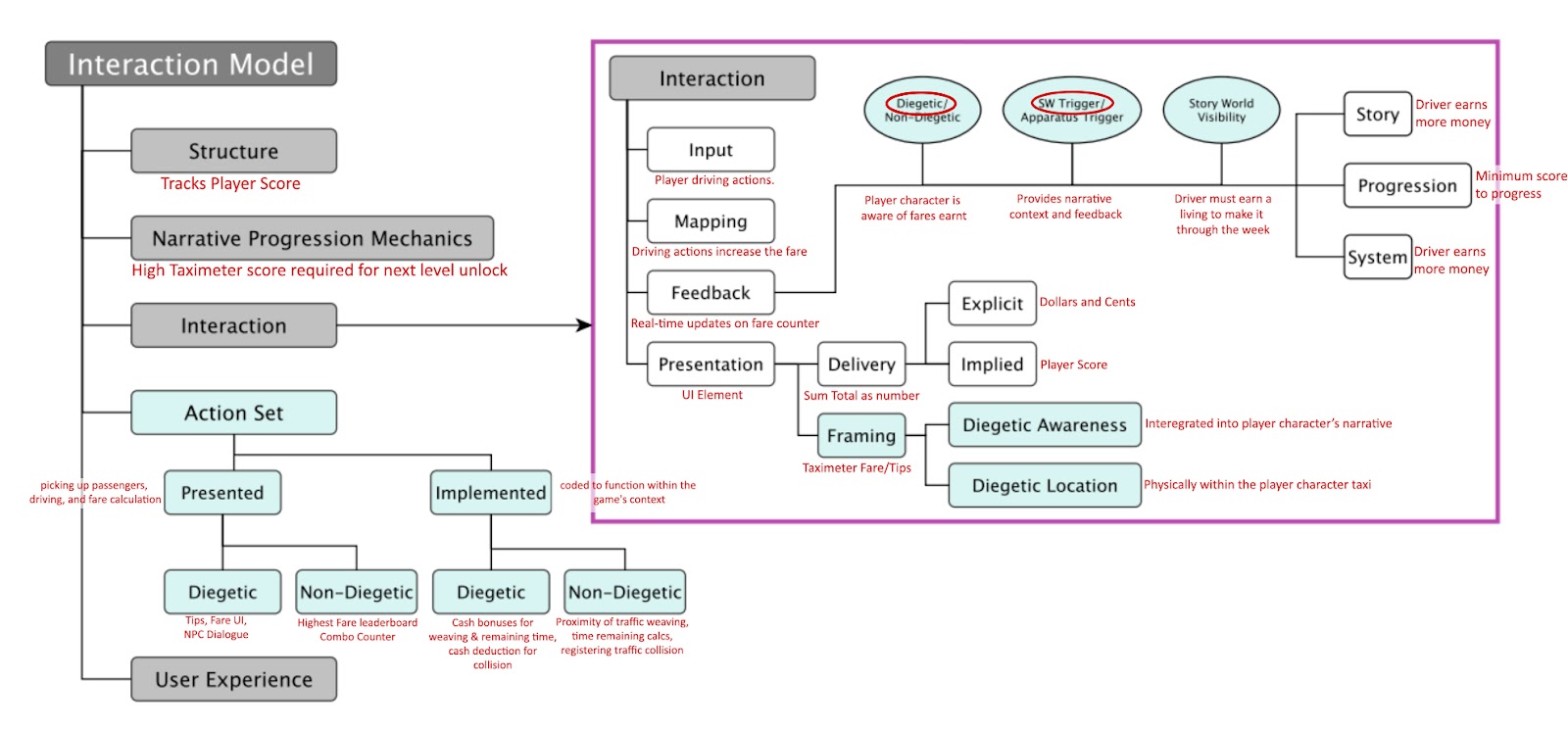
Consider the taximeter example from Crazy Taxi. We can map player interaction with this diegetically framed component, tracking how interaction impacts the narrative and underlying systems and, in turn, player decision-making.
When a game’s diegetic boundary is unestablished, players often rely on previous experiences to guide them, leading to counterintuitive interactions with unconventional mechanics. For example, players conditioned by games such as Space Invaders or Pac-Man might presume that achieving a high score requires methodical and cautious gameplay to avoid harm.
Transposing this mindset to Crazy Taxi might lead players to take safe routes, thereby missing core gameplay elements like risky shortcuts, traffic weaving, and jumping ramps. By framing the high score diegetically, Crazy Taxi recontextualises the mechanic, emphasising the intended gameplay style to distinguish it from players' previous experiences.
Application
Well, what do we do with all this now? In the words of Missy Elliot, we flip it and reverse it. We apply what worked in our studies to new concepts, fitting them to new ideas. In this case, I was presented with a third-person shooter that played like an arcade time trial, a unique and fun spin on traditional gameplay from a developer who had nailed the execution but had zero concept for creative direction. He asked if I'd want to partner up and work something out with him.
After a few meetings, pitches, mood boards and back-and-forths it was decided the concept of an influencer-driven society where you play as a bounty hunter content creator would be fun as heck.
When finding a creative direction for a third-person shooter with a time trial mechanic, two major challenges stood out to me: distinguishing the game from the large pool of existing third-person shooters on the market and managing player expectations when introducing a time trial mechanic within a genre with well-established playstyle preconceptions.
So let’s apply some learnings to this new concept to address this!
Viewer Engagement UI Flavour Text:

Framing the countdown timer as “viewer engagement” could create a strong thematic throughline that supports a narrative and style when established later in development. This would ensure that the time trial mechanic feels fresh and innovative rather than derivative. This will not alter the countdown function in any way; it just provides flavour text for framing.
The countdown timer, when contextualised as a viewer engagement metric within the game’s narrative, could be modelled as such:
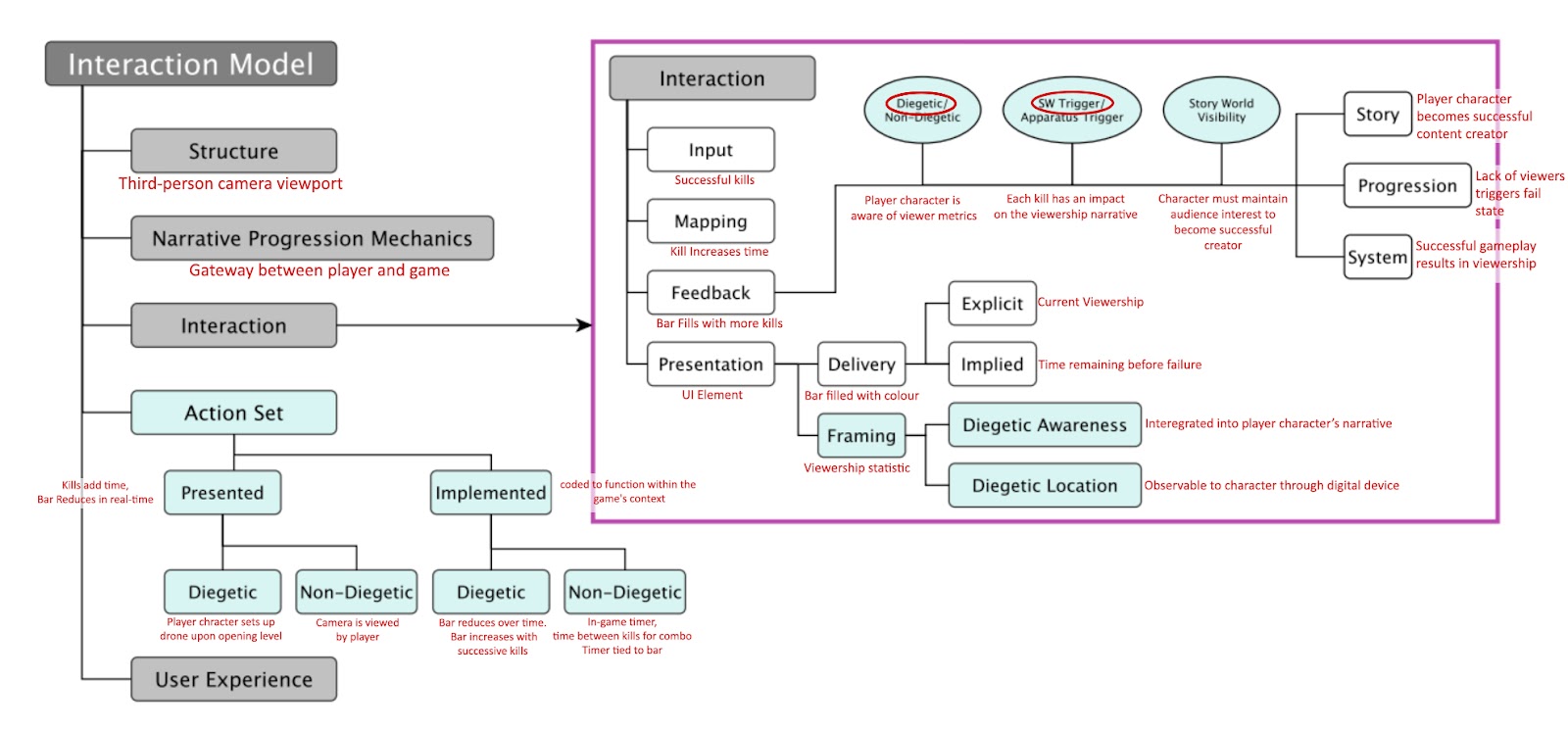
Providing the context that the player failed due to losing audience interest makes the failure feel more meaningful and integrated into the game's world. This contrasts with an arbitrary time limit, where failure occurs simply because the developer has imposed an arbitrary time limit. The player’s performance and ability to engage viewers become the focus, creating a more immersive and satisfying experience.
Third-Person Camera Contextualisation:
Framing the camera as a drone, set up by the player character to record their mission encourages fluid movement, choreographed kills, and reduced idle time by diegetically framing the gameplay as a performance. This perspective enhances the game's thematic cohesion by reinforcing the content creator angle. The drone camera captures the player's actions and constantly reminds them that they are performing for an audience.

The third-person camera, when contextualised as a drone within the game’s narrative, could be modelled as such:
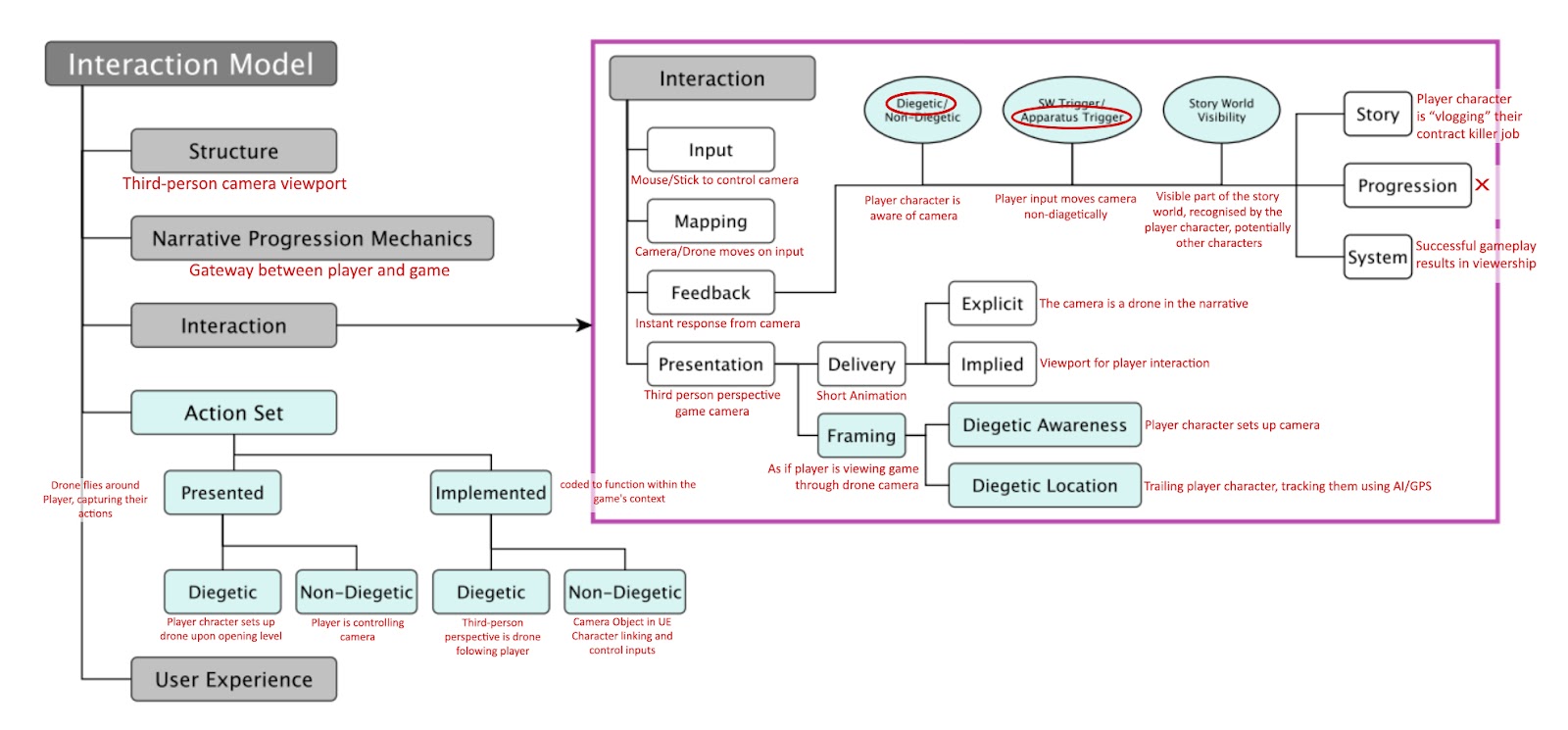
This interaction promotes a sense of urgency and dynamism, encouraging players to move continuously and execute stylish, choreographed kills. The visual framing of the drone camera integrates with the narrative, emphasising that every moment of action is being recorded and broadcast to viewers. This context makes the gameplay feel more purposeful and immersive, as players are constantly aware of their audience and motivated to perform for them.
This framing device helps maintain a fast-paced, engaging experience by minimising idle time and encouraging a more active playstyle. This differentiates the game from other third-person shooters and reinforces the unique narrative concept, making the player's role as a content creator bounty hunter feel authentic and compelling.
Neat Right?
Hopefully you thought so! Anyway, that’s a look into my creative process, at least for these two very specific elements of a much larger product. I just kinda look for inspiration, break it down completely, arguably to an unnecessary extent and then use it how I wanna!
If you did indeed think this was neat you should really check out "There's No Point in Saving Anymore": Diegesis and Interactional Metalepsis in Pony Island and Doki Doki Literature Club by Cassandra Barkman. The title alone is an absolute banger, I mean come on. This article was primarily what led me down this route when researching. I’m gonna talk about DDLC in my next blog post I reckon, I have some thoughts on that god damn game.
25/05/24
Haha! I have a lil webzone. Neat! It’s a bit boring right now because I need a break from CSS after making a functioning Lightwave 3.5 recreation. That took all my effort and so now the content looks a bit boring because I really can’t be arsed at this current moment but oh well, that can come after, now it’s all functioning and the overall vibe is right.
It was hella fun though, super tricky and frustrating at times but that just made it all the more rewarding when it did work! Having a lil space on the internet is fun, I’ve been making lil things for the internet for ages but never really put in the effort to actually have something that I made, from scratch with my bare hands. I do now though biiiiitch.
I feel like it could be more though so I’ll keep at it whenever I have a spark of inspiration. Shoutout to Diggon for making a sick youtube video that inspired the whole thing. As soon as I got through it I was like ok, I actually gotta do this. And she was right! It was fun as heck!
As a distinctly not social media kinda guy this is a nice space to just throw out thoughts and keep all my doodads in one place whenever I wanna show someone! Like when I visit my mum and she’s like ‘what are you up to these days Liam?” and I’ll be like ‘https://the3dzone.neocities.org/blog#post-1 mum!’.
Plus! It's all mine! I don't have to fill out any content I don't want and I can add a bunch of crap that would never go on social media!
Anyway this one’s kinda erratic, I’m just kinda keen that it exists and wanted to log that, I’ll probably say something with coherence and a point next time. I often find myself with a train of thought I wanna share but I had no medium, not outlet y’know? UNTIL TODAY!
Do hang around, I will be back with more content. Uh I might have to figure out a way so that people get updated with each new blog post or something, I've never had a blog before so this is kinda out of my wheelhouse I guess.


